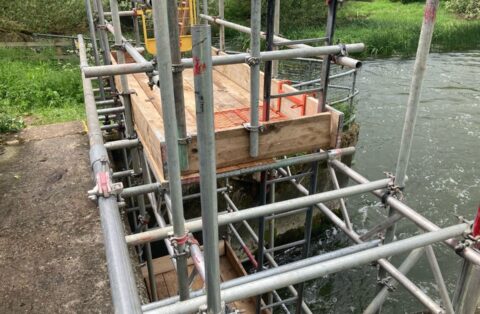One of the gates had become stuck at a high level resulting in excessive water flow, lowing water levels and water pressure and putting upstream embankments at risk of collapsing. This problem was also affecting the old millstream leading to the culverts running underneath the old mill building. While the water levels under the mill structure were so low, Stonbury was employed to inspect the condition of the culverts and facilitate investigation of the damaged sluice.
After scaffolding had been erected by a specialist sub-contractor, Stonbury deployed stop logs into the masonry channels of the sluice, allowing a closer inspection of the sluice gate structure to be carried out. Stonbury’s in-house specialist confined space entry team conducted a visual inspection of the culvert structure and completed repairs to damaged brickwork on front-facing abutments.
Secondary temporary access was erected down into the sluice channel to provide access to the sluice gate trod wheels. It became apparent these had failed due to corrosion over time, resulting in the gate actuators tripping out during automatic movements. The team were able to immediately free the wheels by cleaning off corrosion, applying environmentally safe lubricants and refabricating the distorted metal framework.
The inspection revealed that the second gate had also suffered excessive corrosion to the side where one of the operating steel ropes was anchored. Holding the gate at a suitable height using lifting tackle and applying props underneath as a secondary safety measure, Stonbury removed the corroded section and welded a newly fabricated section of steel framework into place.
Stonbury’s early involvement at the inspection stage meant the specialist team were able to offer solutions for both the damaged brickwork and the malfunctioning sluice gate as soon they became apparent, helping the client avoid an unnecessarily expensive, carbon-heavy and time-consuming replacement.











